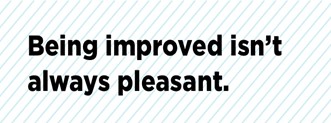Leadership development: is it worth it?

BEING A GREAT LEADER
Most leaders are not born great, but work hard at it. It is not easy nor always fun. And then (like being a parent) just when you think you have it licked, suddenly you are not so sure. Our leadership is up for inspection every day. What is our strategy now? How do I handle those squabbling managers? A big change in our organisation is needed.
Has this thought entered your head?
“I know what to do, but I don’t know if I can do it.”
Knowing what to do already makes you a good leader. Being aware of your vulnerability and seeking help makes you great.
A recent client commented, “ Yes I understand the seriousness of our organisational problem and I know I need to do something different. I’m just not comfortable with it.” This was Kate, a CEO I was coaching who recognised the issue, knew fundamental change was required but was avoiding it because of her own personal worldview or mindset. The real challenge was working on helping her to change her own mindset so she could change the organization.
She was facing a change that could not be successfully negotiated without making her own deep change.
DEEP CHANGE
Which leads me to recommend a recent book that is truly a great leadership change study. Written by Robert E. Quinn who along with Kim Cameron, wrote the original Developing management skills text that James carlopio and I developed into our textbook of the same name for the Australian context. His book, The Deep Change Field Guide: A Personal Course to Discovering the Leader Within is a study in keeping with my strong theme of,’ you cannot change your leadership skills until you change yourself.’
Here are some excerpts you may find compelling.
“Change attempts often fail because of the assumptions we make. We often find ourselves in situations that require us to adapt but choose to distort reality and deny what the world is telling us.”
For those few of us who truly want to be excellent leaders, Quinn says we have to be at the edge, a place of uncertainty and learning. “When we are committed to a higher purpose, we move forward through the fear of conflict, and as we do, we learn and we see in new ways.”
ORGANISATIONAL CHANGE
Quinn continues, “Change has to include a change process based on adaptation. Leaders try things, work together to evaluate the results, and then make adjustments and try again. As we communicate with one another, our assumptions change. Together, we learn the way to our goal: we build the bridge as we walk on it. It is a process of deep change. ”
He echoes works by Drucker, Lencioni, Boyatzis, Goleman, amongst many others, on working together for better outcomes. Naturally his deep change concept also prods us about being vulnerable in the manner of Brown and Millman.
Millman says, “We’re all vulnerable. We’re human beings on this planet Earth. We have no idea what we’re doing here. The greatest joy is living in that vulnerability. Which is different from insecurity. There beneath the surface waves of insecurity, in the deepest undercurrents of the soul, dwells our most elemental vulnerability”. Brené Brown has made it her life’s work to study those depths. She tells Debbie: “Vulnerability at its heart is the willingness to show up and be seen when you can’t control perception.”
Millman continues, “The one thing that we all have in common is… the paradox of vulnerability: that when I meet you, the very first thing I look for in you is vulnerability, and the very last thing I want to show you is my vulnerability. We try to control perception by simulating invulnerability from behind various masks and armors.”
Compassion, collaboration and vulnerability are the true essentials of great deep change leadership. Collectively this builds trust.
Quinn continues, “Deep change is a fundamentally different process because it requires people to develop new expectations. As people experience deep change, they move from their old assumptions to a new set of assumptions. They start to see, feel, and think differently.”
He presents the notion, widely shared by philosophers that when we feel uncomfortable, we are ready to learn. Learning drives deep change. We increase our capacity by being fully challenged, and this needs to be supported and encouraged by the organisation through engagement and learning.
It is our own biases, perceptions and actions that often contribute to the problems we set out to solve. Deep change can only succeed with first engaging in personal change.
If you’re serious about being a great leader and want to change deeply, then work your way through Robert’s book.
I would be pleased to hear how your journey on becoming a better leader progresses.
. 
Graham@mca-group.com.au


